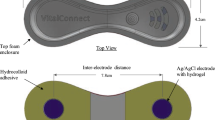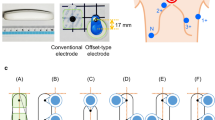Abstract
Purpose
Early detection of cardiac arrhythmias is a major opportunity for mobile health, as wearable devices nowadays available can detect single-lead electrocardiogram (ECG). The study aims to validate the in-ear region as a new anatomical site for ECG signal detection and looks towards designing innovative ECG wearable devices.
Methods
We performed ECG using KardiaMobile device (AliveCor®) on 35 healthy volunteers. First, ECG was detected by standard modality using both hands. Then, ECG was detected using the left in-ear region instead of the right hand. All the recorded ECGs were analyzed by the device and by two cardiologists in blind testing.
Results
We successfully collected 70 ECGs performed on 35 volunteers (male 54%, age 39.1 ± 10.7 years; BMI 22.9 ± 2.89 kg/m2) with no differences observed by KardiaMobile in ECG reports detected in the two different modalities. All the ECGs were reported as normal by the device and the two cardiologists. Moreover, linear regression analysis showed good correlation between the amplitude (mV) of P (r = 0.76; r2 = 0.57; p < 0.0001) and QRS waves (r = 0.81; r2 = 0.65; p < 0.0001), the intervals (ms) of PR (r = 0.91; r2 = 0.83; p < 0.0001; LOA − 0.60–0.41; CC = 0.91), QRS (r = 0.78; r2 = 0.61; p < 0.0001; LOA − 0.49–0.43; CC = 0.78), QT (r = 0.85; r2 = 0.71; p < 0.0001; LOA − 1.31–1.20; CC = 0.85), and heart rate (r = 0.94; r2 = 0.89; p < 0.0001; LOA − 7.82–7.76; CC = 0.94) detected in two different modalities.
Conclusion
The in-ear region is a reliable novel anatomical site for ECG signal detection in normal healthy subjects. Further studies are needed to validate this new ECG detection modality also in case of cardiac arrhythmias and to support the development of new wearable devices.







Similar content being viewed by others
References
Turakhia MP, Kaiser DW. Transforming the care of atrial fibrillation with mobile health. J Interv Card Electrophysiol. 2016;47:45–50.
Chugh SS, Havmoeller R, Narayanan K, Singh D, Rienstra M, Benjamin EJ, et al. Worldwide epidemiology of atrial fibrillation: a global burden of disease 2010 study. Circulation. 2014;129:837–47.
Colilla S, Crow A, Petkun W, Singer DE, Simon T, Liu X. Estimates of current and future incidence and prevalence of atrial fibrillation in the U.S. adult population. Am J Cardiol. 2013;112:1142–7.
Krijthe BP, Kunst A, Benjamin EJ, Lip GY, Franco OH, Hofman A, et al. Projections on the number of individuals with atrial fibrillation in the European Union, from 2000 to 2060. Eur Heart J. 2013;34:2746–51.
Zoni-Berisso M, Lercari F, Carazza T, Domenicucci S. Epidemiology of atrial fibrillation: European perspective. Clin Epidemiol. 2014;6:213–20.
Steinberg JS, Varma N, Cygankiewicz I, Aziz P, Balsam P, Baranchuk A, et al. 2017 ISHNE-HRS expert consensus statement on ambulatory ECG and external cardiac monitoring/telemetry. Heart Rhythm. 2017;14(7):e55–96. https://doi.org/10.1016/j.hrthm.2017.03.038.
Kim MH, Johnston SS, Chu B-C, Dalal MR, Schulman KL. Estimation of total incremental health care costs in patients with atrial fibrillation in the United States. Circ Cardiovasc Qual Out- comes. 2011;4:313–20.
Panaccio MP, Cummins G, Wentworth C, Lanes S, Reynolds SL, Reynolds MW, et al. A common data model to assess cardiovascular hospitalization and mortality in atrial fibrillation patients using administrative claims and medical records. Clin Epidemiol. 2015;7:77–90.
Turakhia MP, Ullal AJ, Hoang DD, Than CT, Miller JD, Friday KJ, et al. Feasibility of extended ambulatory electrocardio- gram monitoring to identify silent atrial fibrillation in high-risk patients: the screening study for un- diagnosed atrial fibrillation (STUDY-AF). Clin Cardiol. 2015;38:285–92.
Freedman B, Camm J, Calkins H, Healey JS, Rosenqvist M, Wang J, et al. Screening for atrial fibrillation: a report of the AF- SCREEN international collaboration. Circulation. 2017;135:1851–67.
Ip JE. Wearable devices for cardiac rhythm diagnosis and management. JAMA. 2019;321(4):337–8.
von Rosenberg W, Chanwimalueang T, Goverdovsky V, Peters NS, Papavassiliou C, Mandic DP. Hearables: feasibility of recording cardiac rhythms from head and in-ear locations. R Soc Open Sci. 2017;4(11):171214.
Zhang Q, Zhou D. Deep arm/ear-ECG image learning for highly wearable biometric human identification. Ann Biomed Eng. 2018;46:122–34.
Nantsupawat T, Nugent K, Phrommintikul A. Atrial fibrillation in the elderly. Drugs Aging. 2013;30(8):593–601.
Author information
Authors and Affiliations
Corresponding author
Additional information
Publisher’s note
Springer Nature remains neutral with regard to jurisdictional claims in published maps and institutional affiliations.
Rights and permissions
About this article
Cite this article
De Lucia, R., Zucchelli, G., Barletta, V. et al. The in-ear region as a novel anatomical site for ECG signal detection: validation study on healthy volunteers. J Interv Card Electrophysiol 60, 93–100 (2021). https://doi.org/10.1007/s10840-020-00709-x
Received:
Accepted:
Published:
Issue Date:
DOI: https://doi.org/10.1007/s10840-020-00709-x




